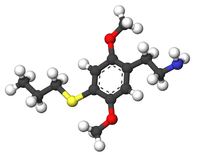2C-T-7
 | |
 | |
 | |
| Names | |
|---|---|
| IUPAC name
2-[2,5-Dimethoxy-4-(propylsulfanyl)phenyl]ethan-1-amine | |
| Other names
2,5-Dimethoxy-4-(propylsulfanyl)phenethylamine, 2,5-Dimethoxy-4-(propylthio)phenethylamine | |
| Identifiers | |
| 207740-26-9 | |
| 3D model (Jmol) | Interactive image |
| ChEMBL | ChEMBL126432 |
| ChemSpider | 21106233 |
| |
| |
| Properties | |
| C13H21NO2S | |
| Molar mass | 255.38 g/mol |
| Melting point | 206 to 207 °C (403 to 405 °F; 479 to 480 K) |
| Except where otherwise noted, data are given for materials in their standard state (at 25 °C [77 °F], 100 kPa). | |
| | |
| Infobox references | |
2C-T-7 is a psychedelic phenethylamine of the 2C family. In his book PiHKAL: A Chemical Love Story, Alexander Shulgin lists the dosage range as 10 to 30 mg. 2C-T-7 is generally taken orally, and produces psychedelic and entactogenic effects that last 8 to 15 hours.[1] Up until Operation Web Tryp and three deaths, two of which involved the use of other drugs in addition to 2C-T-7, and one which involved an excessive insufflated dose, 2C-T-7 was sold commercially in Dutch and Japanese smartshops and online. It is known on the streets as Blue Mystic or 7th Heaven.[2][3] There has been little real research done on this chemical other than Shulgin's comments in PiHKAL and a few small animal studies mostly aimed at detecting metabolites.
Pharmacology
The mechanism that produces the psychedelic and entactogenic effects of 2C-T-7 is most likely to result from action as a 5-HT2A serotonin receptor agonist in the brain, a mechanism of action shared by all of the hallucinogenic tryptamines and phenethylamines.[4]
Effects
2C-T-7 is psychedelic. In PiHKAL, Shulgin records that the hallucinations are unique, and that the chemical may cause muscle tension and an altered vocal quality. Shulgin suggested reading about amateur research on 2C-T-7's effects.[5] Erowid gives the following effects list:
Positive
- sense of well-being (enhanced lucidity, sense of inner peace)
- emotional opening
- significant closed and open eye visuals
- increased appreciation of music
Neutral
- general change in consciousness (as with most psychoactives)
- pupil dilation
- change in perception of time
- visual hallucinations
- auditory hallucinations
Negative
- sexual dysfunction
- arrhythmia
- paranoia
- psychotic break
- nausea and vomiting
- muscle tension
- insomnia
- muscle tremors and/or convulsions
- memory loss (at higher doses)
- potential trigger of HPPD
- delirium (at higher doses) (potentially dangerous)
- violent behavior (at higher doses)
- tachycardia
The drug can be taken orally or snorted, although nasal administration is reported to be extremely painful.[6] Use of 2C-T-7 as a nootropic at low doses of 1–10 mg has been reported, and it may be useful for this purpose in a similar manner to LSD, which shows modest stimulant and nootropic effects at doses of 10 µg.
Deaths
The Partnership for a Drug-Free America reports that 2C-T-7 can be lethal even in small doses;[7] however, they provide no source for their claim and of the three known deaths of 2C-T-7 intoxicated individuals, all involved either excessive insufflated doses or the concomitant ingestion of other stimulants such as ephedrine and MDMA. There have been at least three reported deaths related to 2C-T-7 use as of August 2007, mainly at insufflated doses of 30 mg or more[8][9] or combined with stimulants such as MDMA,[10] as well as a number of very uncomfortably intense effects and hospitalizations, these mostly followed insufflation of 2C-T-7. In January 2002, Rolling Stone published an article about 2C-T-7 entitled "The New (legal) Killer Drug",[11] although the legal status of the drug was misrepresented in the article, as 2C-T-7 may have been already illegal under the United States' legally ambiguous analog act.[12] A detailed response on the website Disinformation challenged the accuracy of much of the reporting in that Rolling Stone article.[13]
All of these known deaths of individuals under the influence of 2C-T-7, therefore, occurred in those known either to be intoxicated with potentially deadly[14] stimulants such as ephedrine or MDMA or after the individual insufflated an excessive amount of 2C-T-7—excessive being an amount greater than necessary to induce the full range of the drug's effects, such as the reported 35 mg insufflated dose taken by the individual who died in the fall of 2000. This reported dose was characterized as "excessive" by the US DEA.
Legal status
Around the year 2000, 2C-T-7 began to change from an obscure chemical to a drug used at parties and clubs in North America and Europe as it became available through a number of grey-market commercial vendors. This aroused the attention of the authorities, and many countries have since scheduled the chemical.
Germany
2C-T-7 is scheduled in Germany. (BTMG)
Australia
In Australia, 2C-T-2 and 2C-T-7 are covered by the country's analogue drug laws.
Canada
2C-T-7 is not scheduled in Canada.[15]
As of October 31st, 2016; 2C-T-7 is a controlled substance (Schedule III) in Canada.[16]
China
As of October 2015 2C-T-7 is a controlled substance in China.[17]
The Netherlands
The Netherlands was the first country in the world to ban 2C-T-7, after being sold in smartshops for a short period. After 2C-T-2 was first banned, 2C-T-7 quickly appeared on the market, but was soon banned as well. 2C-T-7 is a list I drug of the Opium Law.
Sweden
Schedule I in Sweden.[18] 2C-T-7 was first classified as "health hazard" under the act Lagen om förbud mot vissa hälsofarliga varor (translated Act on the Prohibition of Certain Goods Dangerous to Health) as of April 1, 1999 under SFS 1999:58[19] that made it illegal to sell or possess.
UK
In 1999, Alexander Shulgin was sent a copy of a letter from the British Home Office to several of its administrative associates that in effect placed all compounds listed in PiHKAL into Class A.
US
On September 20, 2002, 2C-T-7 was classified as a Schedule I substance in the United States by an emergency ruling by the DEA. On March 18, 2004, the DEA published a Final Rule in the Federal Register permanently placing 2C-T-7 in Schedule I. (69 FR 12794).[20][21][22]
Notes
- ↑ Alexander Shulgin. "PIHKAL #43".
- ↑ Platoni, Kara. "2C-T-7's Bad Trip". East Bay Express May 1, 2002: "In 1999 it made its first commercial appearance in the Netherlands' drug-dealing smart shops in both tablet and powder form. It was given the street name "Blue Mystic," perhaps in order to differentiate it from its chemical cousin, another Shulgin creation named 2C-T-2"
- ↑ O'Connell, Chris. "A psychedelic summer". Newsweek Aug. 19 2002: http://www.newsweek.com/id/65381?tid=relatedcl
- ↑ Fantegrossi, WE; Harrington AW; Eckler JR; Arshad S; Rabin RA; Winter JC; Coop A; Rice KC; Woods JH (September 2005). "Hallucinogen-like actions of 2,5-dimethoxy-4-(n)-propylthiophenethylamine (2C-T-7) in mice and rats". Psychopharmacology (Berlin). 181 (3): 496–503. doi:10.1007/s00213-005-0009-4. PMID 15983786.
- ↑ Shulgin, Dr Alexander (June 28, 2001). "2C-T-7". Ask Dr Shulgin. Centre for Cognitive Liberty and Ethics (COLE). Retrieved August 28, 2009.
- ↑ East Bay Express (January 2, 2007). "2C-T-7's Bad Trip".
- ↑ Partnership for a Drug-Free America. "2C-B, 2C-T-7". Archived from the original on October 19, 2006. Retrieved October 4, 2006.
- ↑ Curtis, B. "Postmortem Identification and Quantitation of 2,5-Dimethoxy-4-n-propylthiophenethylamine Using GC-MSD and GC-NPD". Journal of Analytical Toxicology 27.7 (2003): 493–98: "This compound was initially identified from a routine screening procedure in postmortem urine from a 20-year-old male that died in a local emergency room after reportedly insufflating 35 mg."
- ↑ Platoni, Chris. "A psychedelic summer". East Bay Express, May 1, 2002: "In the same month, Joshua Robbins, a seventeen-year-old from Cordova, Tennessee died after snorting between thirty and thirty-five milligrams of 2C-T-7, not long after taking several other stimulant drugs. According to Rolling Stone, which ran an article on Robbins' death, in the twelve hours before he died Robbins also had consumed Ecstasy, nitrous oxide, and a 'mini-thin' containing ephedrine and guaifenisen."
- ↑ "In the fall of 2000, a young healthy male died following snorting an excessive amount of 2C-T-7. Since this initial 2C-T-7-related death, two additional deaths reported in April 2001 have been linked to 2C-T-7. These two deaths resulted from the co-abuse of 2C-T-7 with MDMA." http://www.deadiversion.usdoj.gov/drugs_concern/2ct7.htm
- ↑ "The New (Legal) Killer Drug". Rolling Stone, January 10, 2002, issue 888: 44–49.
- ↑ 21 USC §813
- ↑ "The new (hip) drug hysteria: a journey into rolling stone's abandonment of journalistic ethics" by Ken Lilly on Disinformation (2002): http://www.disinfo.com/archive/pages/article/id2071/pg1/index.html
- ↑ Baldessarini M.D., Ross J. "SYMPOSIUM: BEHAVIOR MODIFICATION BY DRUGSI. PHARMACOLOGY OF THE AMPHETAMINES". Pediatrics 49.5 (May 1972): 694–701.
- ↑ http://laws-lois.justice.gc.ca/eng/acts/c-38.8/
- ↑ http://gazette.gc.ca/rp-pr/p2/2016/2016-05-04/html/sor-dors72-eng.php
- ↑ "关于印发《非药用类麻醉药品和精神药品列管办法》的通知" (in Chinese). China Food and Drug Administration. 27 September 2015. Retrieved 1 October 2015.
- ↑ http://www.lakemedelsverket.se/upload/lvfs/LVFS_2004-3.pdf
- ↑ http://www.notisum.se/rnp/sls/fakta/a9990058.HTM
- ↑ DEA. "Micgrogram Bulletin Jan 2004".
- ↑ U.S. Department of Justice. "2C-T-7 Fast Facts" (PDF).
- ↑ List of Schedule 1 drugs on the DEA Office of Diversion Control website